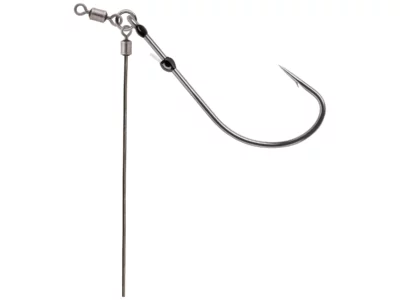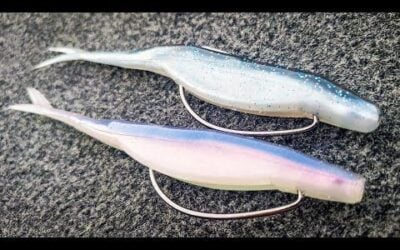The Tokyo rig for bass is a dynamic fishing setup, perfect for elevating your bass fishing game. It’s designed with a wire leader, offset hook, swivel, and weight, all working together to keep your lure suspended, allowing for natural movement and a stunning presentation that bass cannot resist.
This rig excels in dense vegetation and rocky terrains, providing unparalleled adaptability. This guide will outline its unique components, ideal baits, and practical techniques to maximize your success on the water. Whether you’re a beginner or a seasoned angler, mastering the Tokyo rig can significantly boost your catch rate and enhance your overall fishing experience.
Definition and Components
Tokyo Rig—a powerhouse for bass enthusiasts. It’s all about finesse and freedom, delivering a natural presentation that can outsmart even the wariest bass. Let’s break down its components to see what sets it apart.
- Wire Leader: This robust piece allows the bait to hover above the weight. It’s key for maneuvering through cover with minimal snagging.
- Offset Worm Hook: Ensures a solid hook-up. Its design is perfect for use with a range of soft plastics, providing flexibility in bait choice.
- Swivel: Keeps the line twist-free. Essential for maintaining the rig’s integrity and performance in turbulent waters.
- Weight: Customize it. Whether fishing in deep waters or along the shallows, you can adjust the weight to suit your environment.
Why choose a Tokyo Rig over a classic setup like a Texas Rig? Simply put, the Tokyo Rig offers freedom of movement your lure needs. It’s tailor-made for environments packed with vegetation or rocky terrains. And when conditions change, a quick swap of weights lets you adapt on the fly—no need to rig from scratch. In the end, it’s about strategic allure and unbeatable performance.
How to Rig a Tokyo Rig for Bass
So you’ve got the components—now what? It’s time to bring them together for success on the water. Rigging a Tokyo Rig is straightforward, and once you’ve got the hang of it, it becomes second nature.
- Thread the Weight: Begin by threading your weight onto the wire leader. This step ensures the weight remains stable, firmly setting the stage for your bait’s movement.
- Add the Swivel: Attach a swivel to eliminate line twists. This is crucial for maintaining control and effectiveness when submerged.
- Hook Selection: Choose an offset hook that matches your bait’s size. Balance is crucial—ensure your setup will showcase the bait’s movements naturally without hampering action.
- Secure Your Bait: Thread your chosen soft plastic onto the hook, leaving enough exposure for a clean hook set. The fish won’t know what hit them.
Pro Tip: Adjust the wire length according to your aquatic environment. Shorten it for shallow, weedy areas or extend it for deep, open water. Remember, adaptability is key, and each adjustment fine-tunes your chances of success.
Best Baits for the Tokyo Rig
Choosing the right bait can make or break your fishing trip. The Tokyo Rig is versatile, but matching the right bait with the right conditions takes your game up a notch.
Best Bait Choices
- Creature Baits: Ideal for clear waters. With their natural prey appearance, these baits can trigger aggressive strikes.
- Worms: An all-rounder. Finicky bass won’t resist the action of a ribbed or curly-tailed worm.
- Crawfish Imitations: Perfect for rocky bottoms, as they mimic one of bass’s favorite meals.
Selecting the right bait depends not only on environmental conditions but also on what the bass are feeding on at that time. Bright colors work in murky waters, while subtle, natural shades are best for clear waters. Use scents to enhance appeal—sometimes, the aroma is the finishing touch needed to entice a strike.
 Advantages of Using a Tokyo Rig
Advantages of Using a Tokyo Rig
You’ve explored the components and setup—what’s next? Understanding the advantages. The Tokyo Rig for bass is one of the best tools in your fishing arsenal for a reason.
- Enhanced Presentation: The hovering action is less likely to spook bass, attracting them with a naturalized look.
- Versatility in Heavy Cover: It shines where many rigs falter, effortlessly navigating complex underwater landscapes with ease.
- Quick Adjustments: Switch weights swiftly to react to different depths or currents—each modification is simple and efficient.
Embrace the adaptability and precision of the Tokyo Rig for your bass fishing endeavors. With practice, it becomes not just a tool, but a reliable partner in reeling in the catch of the day.
Techniques for Maximizing Success
When you’re using the Tokyo Rig, understanding the right techniques can skyrocket your success rate. It’s about grasping how to maneuver and adapt your rig in different situations. Whether you’re casting out on a calm lake or fishing in more challenging conditions, we’ve got you covered.
Casting Methods
To start strong, master your casting technique. A well-executed cast can be the difference between an ordinary day of fishing and one filled with bass trophies. Aim for precision and stealth, especially when targeting areas with dense cover or structure.
- Cast gently into the water to avoid alarming the fish.
- Focus on target zones, such as areas with shade, submerged vegetation, or near underwater structures where bass naturally linger.
- Use a sidearm cast for windy conditions to keep the line low and maintain accuracy.
Retrieval Techniques
Once your Tokyo Rig is in the water, the retrieval technique takes center stage. This is where the magic happens. Engage the bass with varied retrieval speeds and actions, as it’s often the subtle changes that provoke strikes.
Slow and Steady
For bass hesitant in cooler temperatures, a slow drag approach can be a winner. This method allows the bait to mimic the cautious movement of natural prey, enticing more strikes.
- Slowly reel in to give the bait a steady, natural motion.
- Periodic pauses in retrieval can mimic the behavior of an injured or weary fish.
Twitch and Pause
In warmer waters or when bass are highly active, a twitch and pause method can be particularly effective. Fish react to sudden movement, often interpreting it as fleeing prey.
- Employ swift, short twitches followed by a longer pause.
- Vary the length of your pauses to match the activity level of the fish.
Remember, it’s essential to read the conditions around you and adjust accordingly. Seeing what works in real-time can transform a slow afternoon into a banner day of fishing.
When and Where to Use the Tokyo Rig
Deciding when and where to deploy your Tokyo Rig can significantly impact your results. Each location and season presents unique challenges and opportunities, and adapting to these can enhance your fishing journey.
Prime Locations
The versatility of the Tokyo Rig makes it ideal for a range of environments. Here’s where it particularly shines:
- Dense Vegetation: Navigate through weed beds and overgrown areas with ease, as the rig keeps your bait suspended above snags.
- Rocky Bottoms: Its design minimizes snag risks, allowing you to explore rocky terrains with confidence.
- Transition Zones: Areas where depth or water clarity changes rapidly, like drop-offs or ledges, are prime territory for this rig.
Seasonal Adjustments
Understand how seasons affect bass behavior to use the Tokyo Rig wisely:
- Spring: As fish transition through post-spawn, target shallower areas where bass feed heavily to recover.
- Summer: In hot months, use the rig in deeper, cooler areas where bass seek refuge.
- Autumn: Focus on areas with available cover when bass prepares for winter, feeding aggressively in preparation.
- Winter: Fish slower and deeper—bass metabolism slows down, and they congregate near stable structures.
Bass swim in schools; joining their migratory patterns through these techniques can yield more significant results.
Common Mistakes and How to Avoid Them
Mastering the Tokyo Rig for bass involves recognizing and avoiding common pitfalls that could hinder your fishing experience. By being aware of these mistakes, you can refine your technique and increase your success rate on your next fishing adventure.
Mistake: Incorrect Weight Selection
Not adapting your weight choice can result in poor bait presentation. Choose weights based on the depth and speed of the current. Too lightweight may not reach the desired depth, while too heavy can dull the action of your bait.
Mistake: Improper Bait Attachment
Improperly securing your bait can prevent natural movement, reducing the effectiveness of the rig. Always ensure the bait is firmly attached yet free enough to mimic real prey.
Mistake: Lack of Technique Variation
Sticking to one retrieval method can lead to missed opportunities. It’s crucial to switch up your retrieval speed and method based on the day’s conditions. Don’t fall into a rhythm; instead, stay dynamic and responsive to what works in real-time.
Take each session as a learning experience. Avoid common errors by reflecting on your sessions—every cast is an opportunity to improve.
Conclusion: Mastering the Tokyo Rig
The Tokyo Rig for Bass is a potent tool in the hands of an informed angler. By understanding each component, refining your rigging and retrieval techniques, and avoiding common mistakes, you’ll maximize your success. Keep experimenting with new methods, and let the Tokyo Rig become your trusted ally in reeling in your best bass yet.






0 Comments